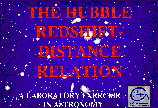

 |
Required Windows SoftwareThis is a zip file that contains an .exe file that will install itself when you run it on your computer.
|
||
| Purpose: To illustrate how the
velocities of galaxies are measured using a photon-counting spectrograph.
To show how this information, along with estimates of galaxy distances
(from their integrated apparent magnitudes) yields the classic Hubble redshift-
distance relation. To determine the value of the Hubble parameter and the
expansion age of the universe.
At the controls of a simulated telescope, students view distant clusters of galaxies and obtain their spectra with a photon counting spectrometer. The telescope offers two fields of view, a wide field view of 2.5 degrees, and a magnified field ("instrument view") of 15 arc-minutes. Stars are represented by realistic point spread functions scaled to magnitude, and galaxies by images from actual CCD frames. In the instrument mode, students can position the slit of a spectrograph on the galaxy and take spectra. The photon counting spectrograph simulates actual Poisson statistics and contains both a sky background and a galaxy spectrum. The relative contribution of the galaxy depends on how much "light" from the image is included in the slit, so that the highest signal-to- noise is obtained when the slit is positioned on the brightest part of the galaxy, just as with a real spectrograph. Students are advised to obtain spectra with signal-to-noise of about 10, so that they can see and measure the Ca H and K lines, which are used to determine the redshift of the galaxy. Wavelengths can be measured using the mouse cursor, and recorded for further analysis. The spectrometer also records the integrated apparent V magnitude of the galaxy, which is used, along with an assumed absolute magnitude, to determine the distance of the galaxy. With this information for five or six galaxies at various distances, students can plot out a Hubble diagram, determine the Hubble parameter, and estimate the age of the universe. A wide variety of instructor-settable options are available. Instructors can construct their own galaxy fields using GENSTAR, a utility supplied by CLEA, and can even install their own image files to represent galaxies. The integration time to reach a given signal- to-noise can be set to conform to the needs of the class and the speed of the computer. Even the value of the Hubble parameter can be specified by the instructor; the default is 75 km/sec/Mpc.
|